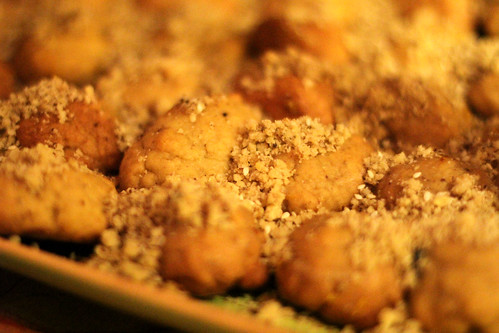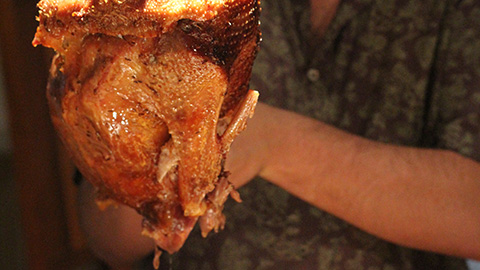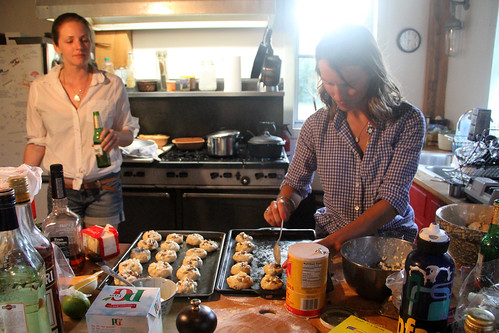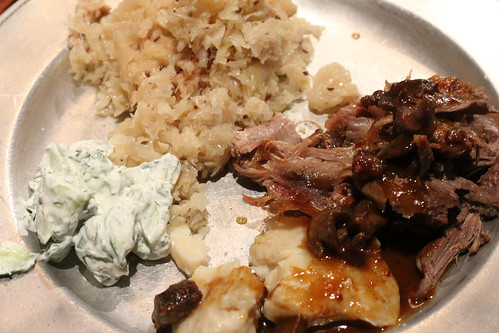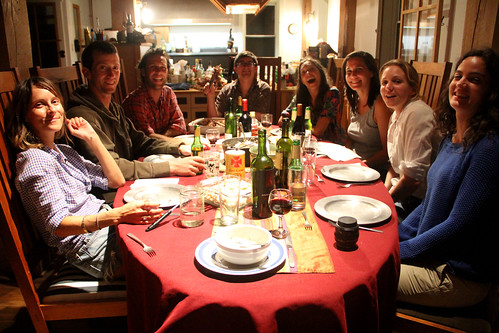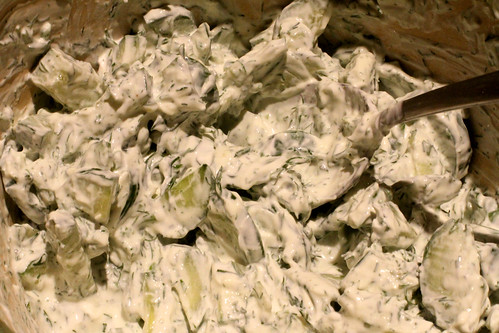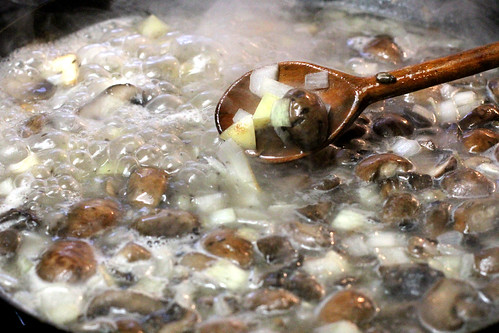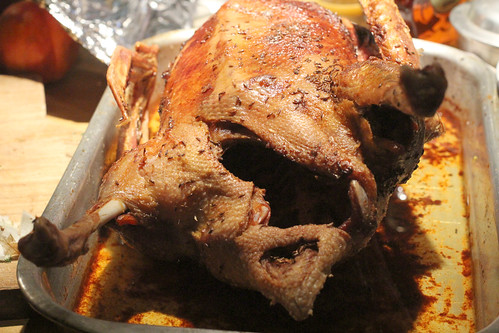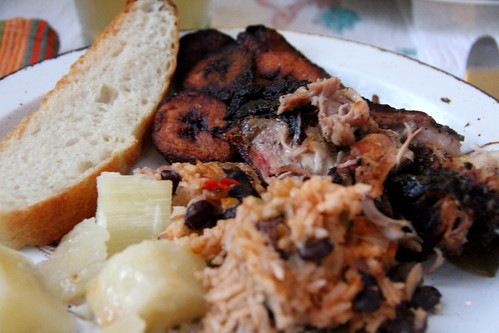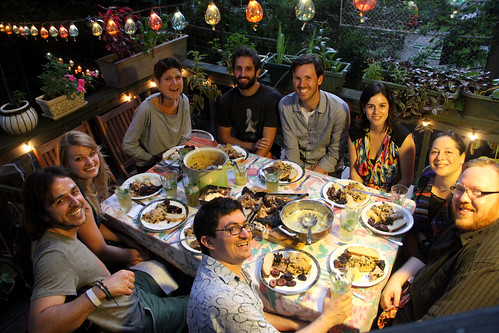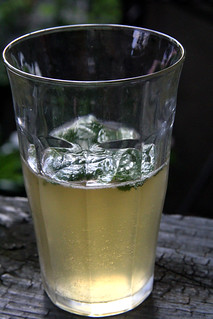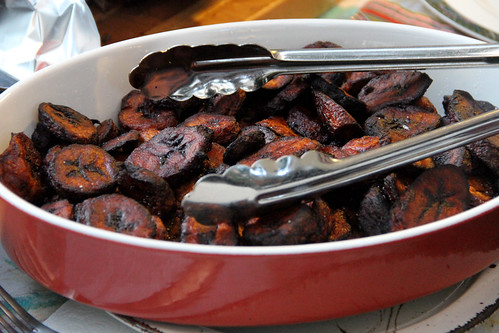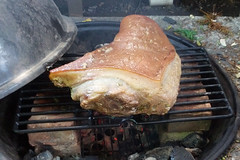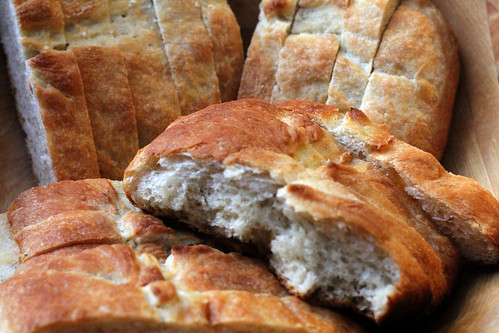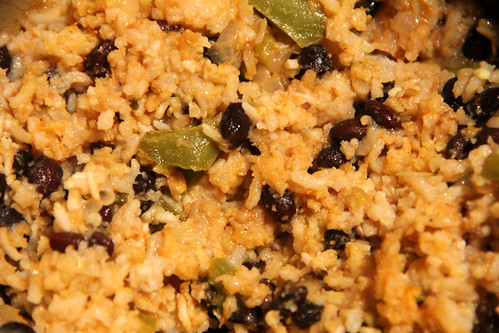Danish cuisine doesn't exactly have a high reputation, among gastronomes nor dietitians, so I had pretty low expectations for the meal. While Denmark famously produces a whole lot of dairy and pork, it has a historical reputation for sending the best stuff abroad and keeping the remainder to feed the populace. Well, I am happy to report that so long as bold, rich flavors are welcome, Danish food is actually pretty good! For this meal I tried to evoke the spirit, if not the reality, of the smørrebrød — literally, butter-bread, the open-faced sandwiches on rye that are the most distinctive and lovely part of the cuisine. While a really good host might have made them for the guests, we set bread, butter, and toppings on the table, and let folks just have at it.

We were pleased to welcome a whole bunch of first-time Noshers! Raven's the only one who'd been before; we were thrilled to welcome Jeremy, Lars (a real half-Dane!), Dada, Julie, Bijou (another half-Dane!), Jess, and Allison (a fellow countries-of-the-world food-schticker at 26dishes!).
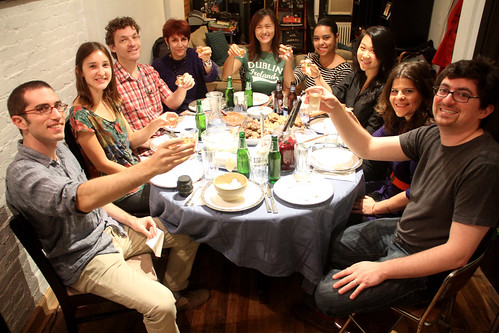
Rugbrød | Sourdough whole rye bread | Recipe
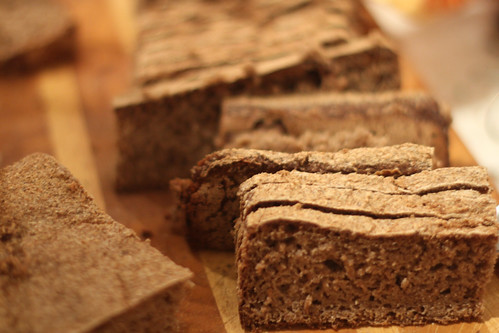
My initial research a few weeks back made it clear that a fresh, dense-but-moist, whole-grain sourdough rye is a core component of Danish cuisine. I found several recipes in searching, but none really struck the intersection of seeming like something someone in Denmark would actually make, and speaking the sort of baking language I understand.
So what luck when I did the search again — specifying "rye chops" because I had the cut grains on hand — and found this marvelous recipe that just happened to be posted a day or two prior! If you already have a sourdough starter, it's no big deal, you just have to plan several days in advance so you can take part of your starter and feed it with rye, and then spend the required day and a half of rising and refrigerating, 2.5 hour bake, and another 24 hour rest before slicing.
The bread is just great. Rich, malty flavor with a very strong backbone of that hearty rye flavor, but what's most wonderful is the surprisingly light crumb and moistness you just don't expect from 100% rye. The only recommendation I can add to the recipe is to remove the bread from the pans before it cools too much; I made the mistake of cooling in the pan, and of the three loaves I made, only the one with corrugated sides released. The other two taste great but are no good for slicing.
Akvavit | Spiced spirits
Akvavit, from the Latin aqua vitae or "water of life," is an infusion of spices into vodka. I guess I could have bought some at the store, but what's the fun in that? Cobbling together indications from several sites, and ignoring suggestions to start with just a few spices, I threw in about a dozen, including cinnamon, coriander, caraway seeds, cardamom, cloves, anise, star anise, and dried lemon peel. I should have left it for a few weeks but only started a few days before the meal, so to give things a head start I toasted the herbs to release the oils, and also gave the bottle a shake every time I walked by the kitchen.
Nobody claimed to love it, and to be fair it was a pretty heady combination of flavors, but I was pleased for what I think passes as a Scandinavian complement from Lars: "Well, this is better than many commercial versions!"
Frikadeller | Fried meatballs | Recipe
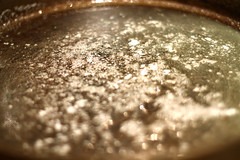
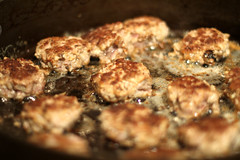
Leverpostej | Liver pate | Recipe
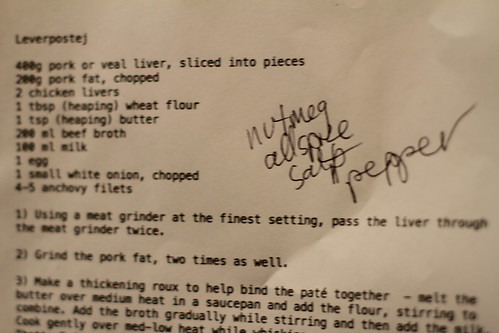
Corinna, a colleague of mine, cautioned against setting up for sandwiches — not only would it take "a lot of preparation," but "you would have to make leverpostej." Tradition demands it! And since I don't pass up a good opportunity to bake with rye, well, I had to make this liver-based pâté.
Now, I can find palmnut sauce, green plantains, and homemade lard easily in New York. But who knew, in a city that loves its bacon and many other parts of the pig, that it would be so hard to find something as elemental as pork liver? After increasingly frantic calls on Friday to some of Manhattan and Brooklyn's best-regarded butchers, all of whom said "I could get it for you in a few days," I finally found a winner in the Meat Hook in Williamsburg, which also kindly ground both the liver and the fat for me. So note, if for some reason you want to make this dish, please call ahead to your butcher and make sure they're ready.
We didn't end up with any photos of the dish, which is just as well because it's roundly unattractive. But for those who enjoy pâté-like dishes, it's a treat to have one that's freshly made. One suggestion is to ignore the recipe's idea to serve warm; apparently it's most often served cold, which also makes it easier to slice.
Syltede rødbeder | Pickled beets | Recipe
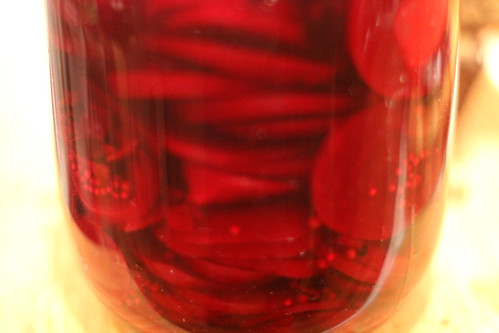
I almost didn't make this, because the beets at the Fairway were shockingly soft. You want beets soft after cooking, not before. But while I was at the Meat Hook, the little produce area in the Brooklyn Kitchen half had these beautiful, local beets that I just couldn't ignore.
Now, a cooking secret for you. I don't know a reliable way to avoid getting stains when cooking. Even when I wear an apron, stuff seems to find its way onto my shirt. So when I'm working intensively with beets or pomegranate or the like, I just take my shirt off. Maybe it increases the risk of a burn on my stomach, but I know I won't stain the clothes! Anyway, so I boiled the beets, cooled them in an ice bath, slipped off the skins, and sliced them while still warm. I threw together a homemade pickling spice with bay leaves, mustard and coriander seeds, cloves, broken cinnamon stick, and probably a few other odds-and-ends I forget, and left it just overnight. Well, the flavors definitely melded, and the beets were very popular, both as a smørrebrød topping and also on their own.
Smør, Marinerede sild, Danablu | Butter, pickled herring, blue cheese
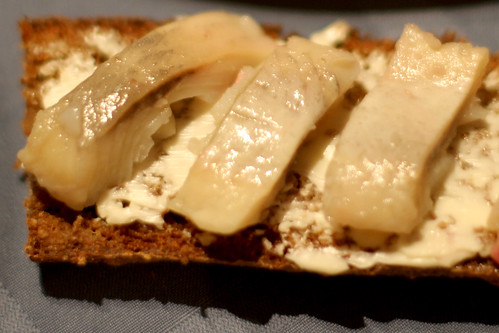
Much as I try to make things myself, sometimes you just gotta buy it. No way I was going to churn my own butter (though I've heard you can) or make my own blue cheese, and even though I tried to find fresh herring to pickle my own, I totally struck out and got some from Shelsky's down the road. Anyway, all of these were excellent smeared on the rye bread for some smørrebrød action.
Kold kartoffelsalat | Cold potato salad | Recipe
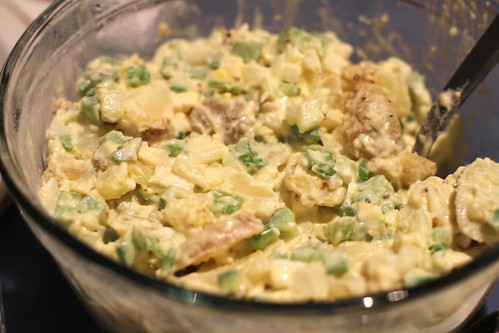
Be sure to use the freshest potatoes you can find, because there's not much seasoning in this salad so the potatoes are meant to shine. However, there is heavy cream and mayonnaise. Yum! I think I was more of a fan of the more vinegar-and-bacon direction of an Austrian potato salad, but I definitely see the value of this creamier kind.
Grønkal | Creamed kale | Recipe
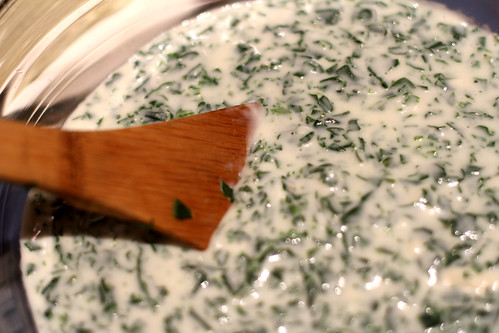
Despite the name and appearance, there's no cream here, just a butter-flour-milk roux with boiled and chopped kale thrown in. I think there was too much sauce for the amount of greens.
Is | Ice cream
Turns out the Danes are the #1 per-capita consumers of ice cream in the world. I too the opportunity to clean out a bunch of ice creams I'd made over the summer: vanilla, mint, saffron-cardamom-pistachio-rosewater, and peach sorbet.
We had a great time, as Lars, Bijou and Allison regaled us with stories of Danish life and culture, and the soundtrack played local pop and other sounds.
Next week we head to a place that also has sourdough-based bread, and plenty of meat and butter — and that's where the similarities end, 'cause it's the little East African nation of Djibouti.
Photos by Laura Hadden, who finally found a rye bread she likes.

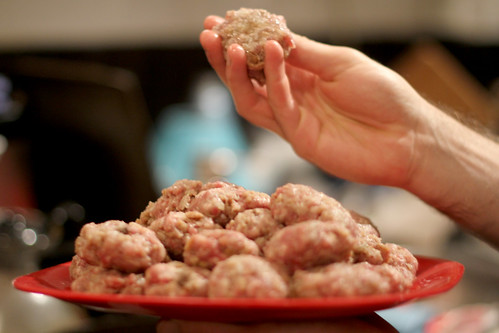














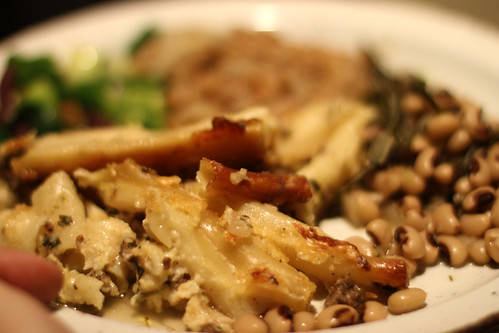
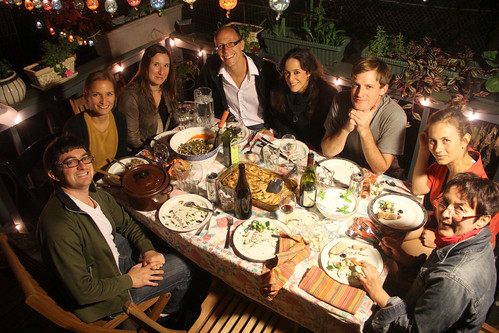 Joining us for this pleasant, post-mosquito night on the back porch, in addition to Iva, were Rachel (who's got a great project going with
Joining us for this pleasant, post-mosquito night on the back porch, in addition to Iva, were Rachel (who's got a great project going with 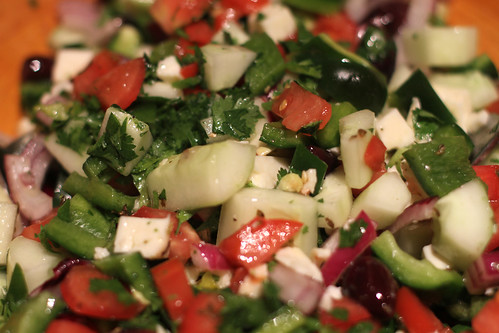 If you've ever had a Greek salad, this is a pretty similar beast, with tomatoes, cucumbers, green peppers, olives and oregano. What makes this Cypriot is the halloumi cheese, which is moister and firmer, and a bit less salty, than feta. Also the dressing is based on lemon juice rather than the vinegar you sometimes see.
If you've ever had a Greek salad, this is a pretty similar beast, with tomatoes, cucumbers, green peppers, olives and oregano. What makes this Cypriot is the halloumi cheese, which is moister and firmer, and a bit less salty, than feta. Also the dressing is based on lemon juice rather than the vinegar you sometimes see.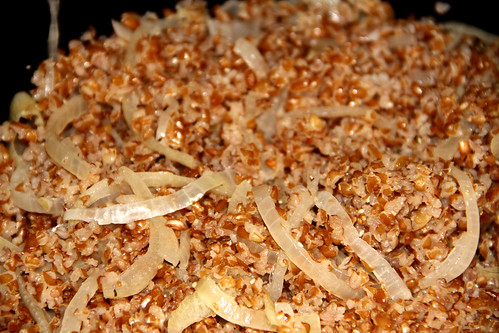 I think I see a bit of Middle East influence in bulgur, or cracked wheat, in this dish! Though the flavor was simple, it was definitely enlivened by some thick yogurt.
I think I see a bit of Middle East influence in bulgur, or cracked wheat, in this dish! Though the flavor was simple, it was definitely enlivened by some thick yogurt.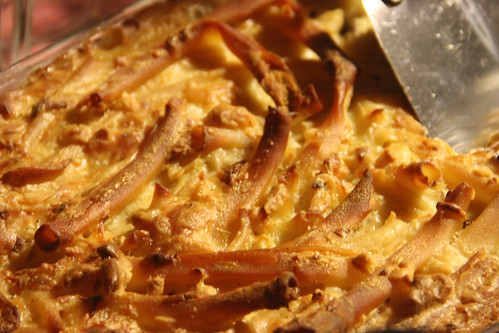 I'd be surprised if it wasn't the Venetians who introduced the pasta used in this casserole which is well known as a Greek dish but which Iva claims is originally from Cyprus. It was certainly tasty, but what was supposed to be a thick and fluffy bechamel of flour, milk and butter was quite runny and kind of drooped down like a cobbler rather than floating on top like a meringue. I think it was my fault for adding the second half of the milk too quickly rather than slowly incorporating it patiently into the pan of milk and flour. Be that as it may this was still plenty yummy.
I'd be surprised if it wasn't the Venetians who introduced the pasta used in this casserole which is well known as a Greek dish but which Iva claims is originally from Cyprus. It was certainly tasty, but what was supposed to be a thick and fluffy bechamel of flour, milk and butter was quite runny and kind of drooped down like a cobbler rather than floating on top like a meringue. I think it was my fault for adding the second half of the milk too quickly rather than slowly incorporating it patiently into the pan of milk and flour. Be that as it may this was still plenty yummy.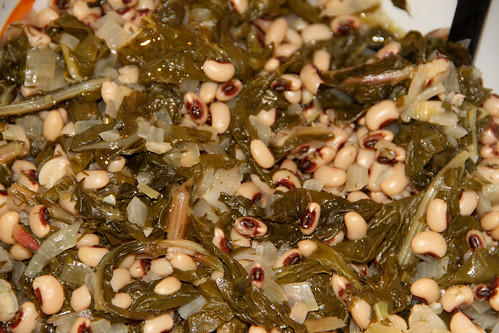 A beautifully rustic combination of legumes and greens. Interestingly, dried black eyed peas cook much more quickly than normal beans, which is good to know if you have limited time. The dish overall was nice and a bit tangy with the lemon, but honestly the leftovers were bolder and in my opinion better when I added red wine, sumac, roasted garlic, Aleppo pepper and more lemon juice.
A beautifully rustic combination of legumes and greens. Interestingly, dried black eyed peas cook much more quickly than normal beans, which is good to know if you have limited time. The dish overall was nice and a bit tangy with the lemon, but honestly the leftovers were bolder and in my opinion better when I added red wine, sumac, roasted garlic, Aleppo pepper and more lemon juice.